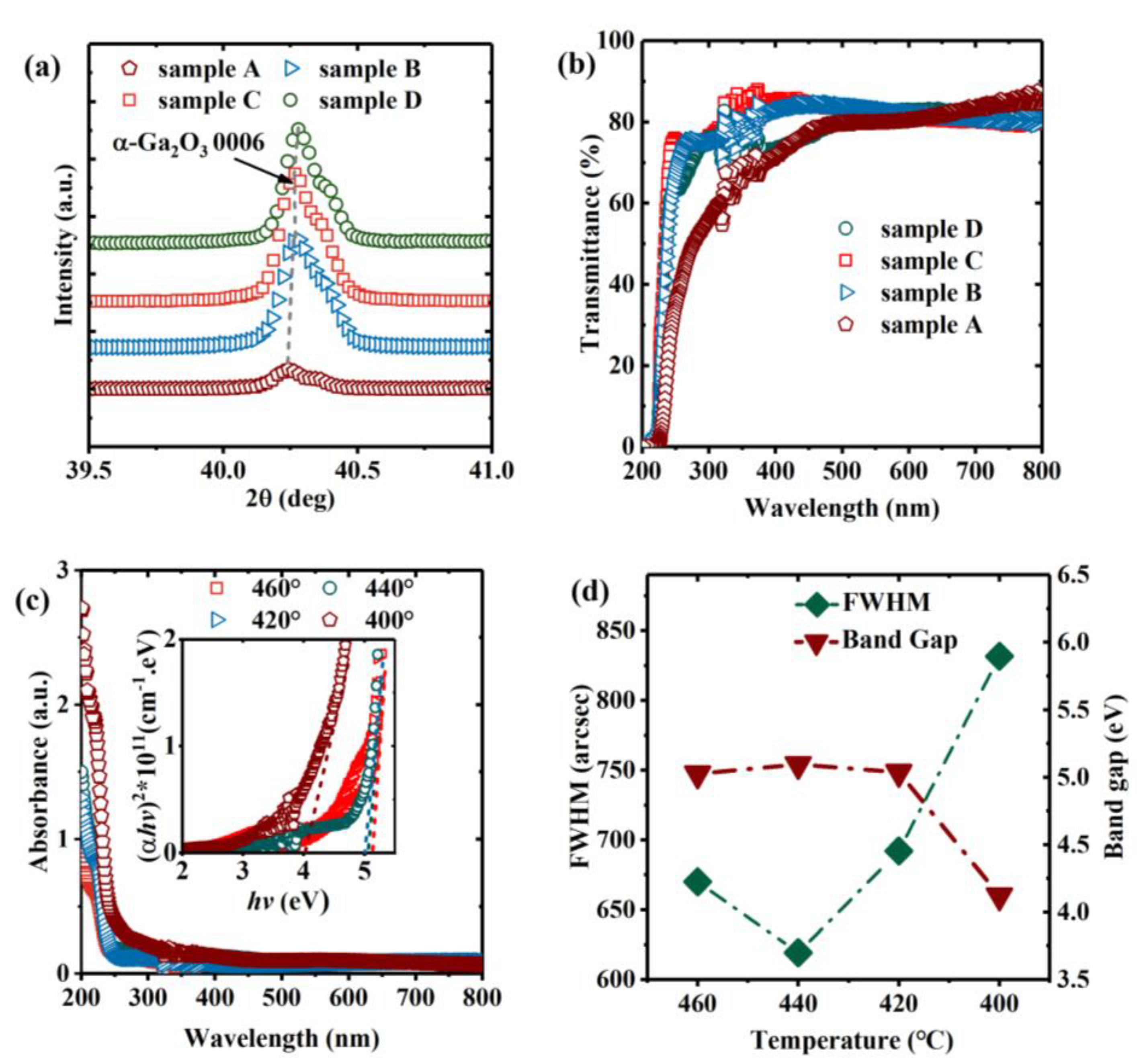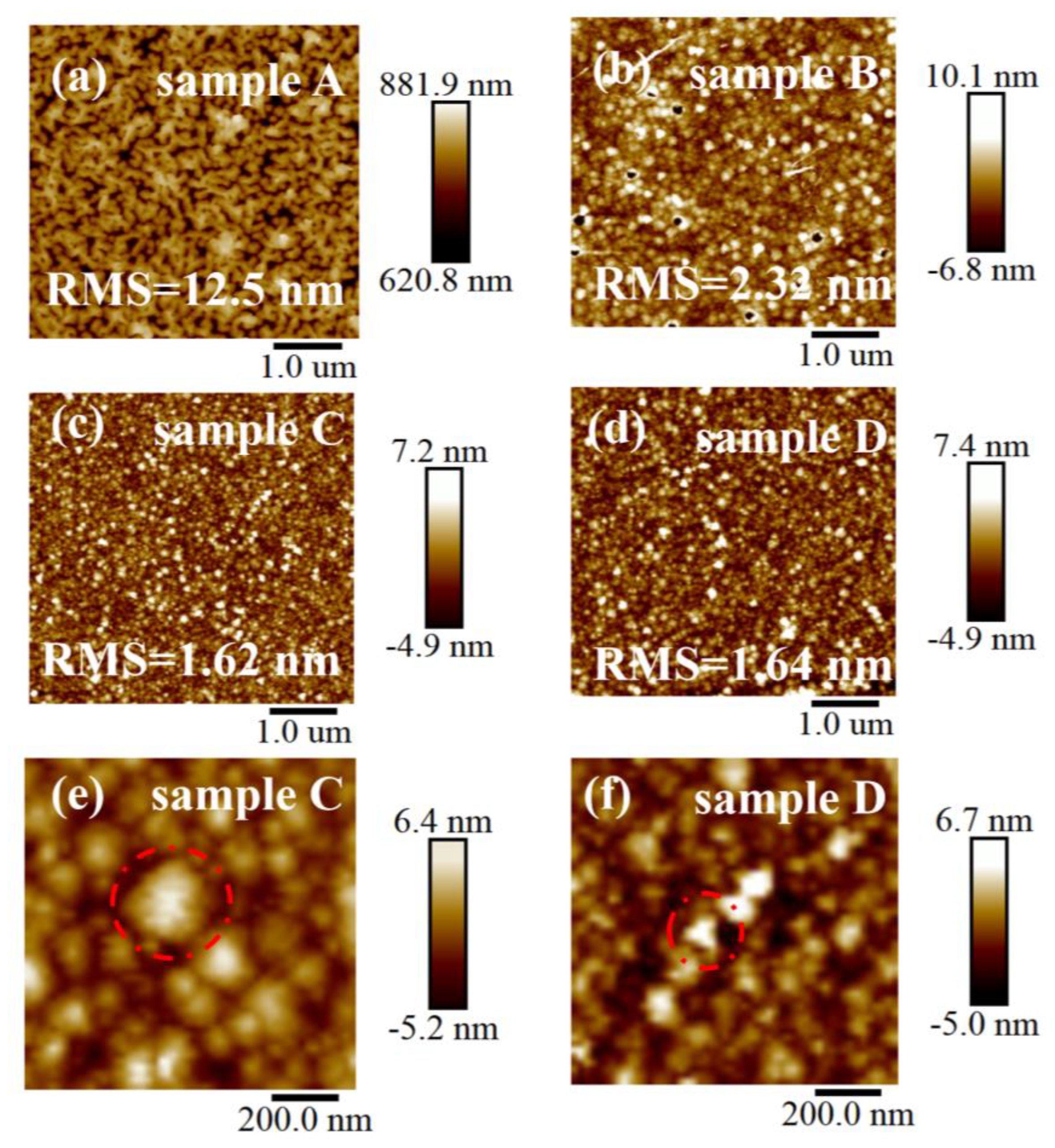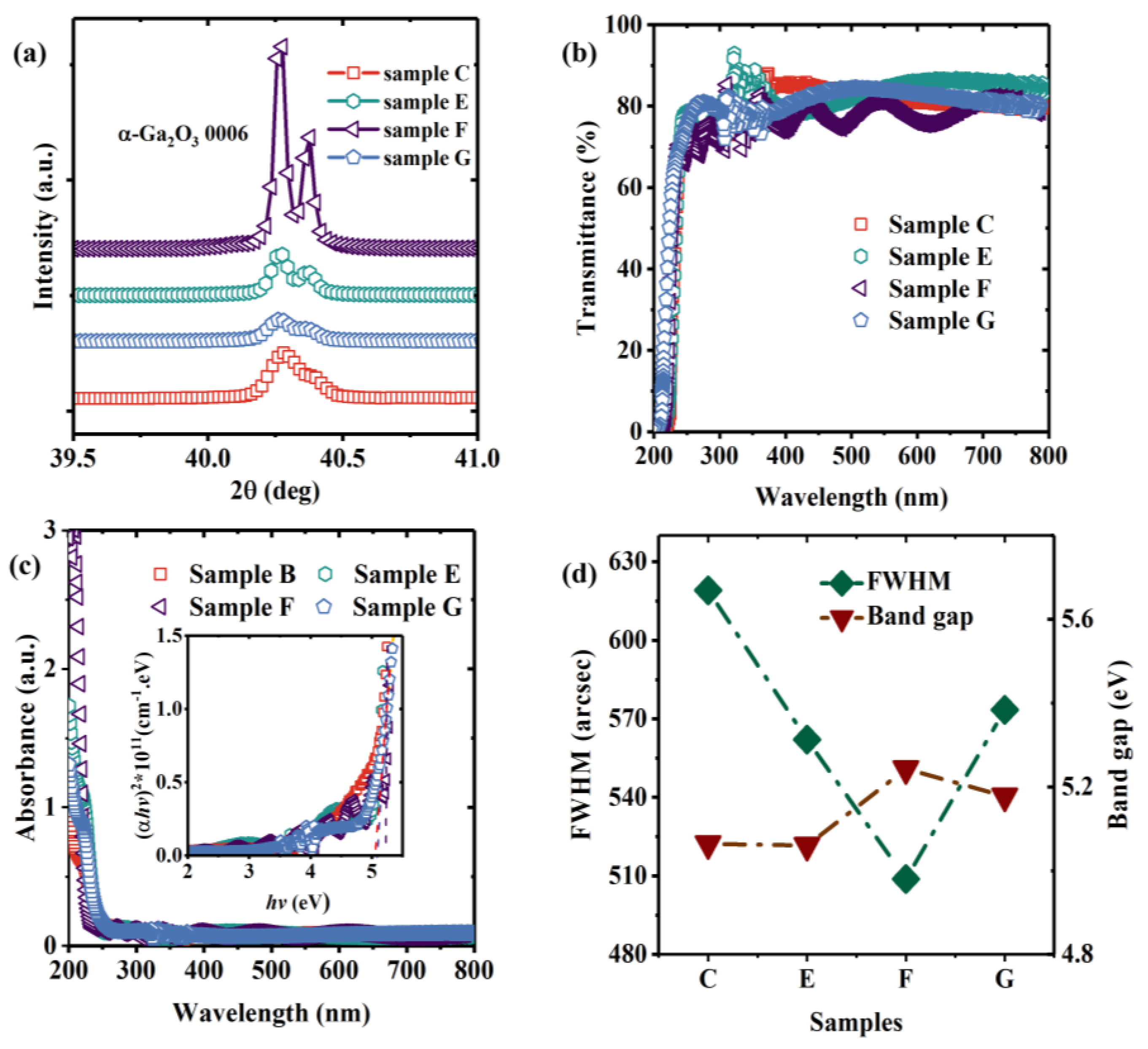A Novel Method for Growing α-Ga2O3 Films Using Mist-CVD Face-to-face Heating Plates
Abstract
:1. Introduction
2. Experimental Section
3. Results and Discussion
4. Conclusions
Author Contributions
Funding
Data Availability Statement
Conflicts of Interest
References
- Hao, J.G.; Ma, T.C.; Chen, X.H.; Kuang, Y.; Li, L.; Li, J.; Ren, F.F.; Gu, S.L.; Tan, H.H.; Jagadish, C.; et al. Phase tailoring and wafer-scale uniform hetero-epitaxy of metastable-phased corundum α-Ga2O3 on sapphire. Appl. Surf. Sci. 2020, 513, 145871. [Google Scholar] [CrossRef]
- Ahmadi, E.; Oshima, Y. Materials issues and devices of α-and β-Ga2O3. J. Appl. Phys. 2019, 126, 160901. [Google Scholar] [CrossRef] [Green Version]
- Zhang, T.; Li, Y.F.; Feng, Q.; Zhang, Y.; Ning, J.; Zhang, J.C.; Hao, Y. Effects of growth pressure on the characteristics of the β-Ga2O3 thin films deposited on (0001) sapphire substrates. Mat. Sci. Semicon. Proc. 2020, 123, 105572. [Google Scholar] [CrossRef]
- Xu, Y.; An, Z.; Zhang, L.; Feng, Q.; Zhang, J.; Hao, Y. Solar blind deep ultraviolet β-Ga2O3 photodetectors grown on sapphire by the Mist-CVD method. Opt. Mater. Express 2018, 8, 2941. [Google Scholar] [CrossRef]
- Tahara, D.; Nishinaka, H.; Noda, M. Use of mist chemical vapor deposition to impart ferroelectric properties to ε-Ga2O3 thin films on SnO2/c-sapphire substrates. Mater. Lett. 2018, 232, 47. [Google Scholar] [CrossRef]
- Kalygina, V.M.; Almaev, A.V.; Novikov, V.A.; Petrova, Y. S. Solar-blind UV detectors based on β-Ga2O3 films. Semiconductor 2020, 54, 682. [Google Scholar] [CrossRef]
- Zhu, W.; Xiong, L.; Si, J.; Hu, Z.; Gao, X.; Long, L.; Li, T.; Wan, R.; Zhang, L.; Wang, L. Influence of deposition temperature on amorphous Ga2O3 solar-blind ultraviolet photodetector. Semicond. Sci. Technol. 2020, 35, 055037. [Google Scholar] [CrossRef]
- Zhang, J.; Liu, Z.; Lin, C.; Lin, J. A simple method to synthesize β-Ga2O3 nanorods and their photoluminescence properties. J. Cryst. Growth 2005, 280, 99. [Google Scholar] [CrossRef]
- Wang, Q.; Chen, J.; Huang, P.; Li, M.; Lu, Y.; Homewood, K.P.; Chang, G.; Chen, H.; He, Y. Influence of growth temperature on the characteristics of β-Ga2O3 epitaxial films and related solar-blind photodetectors. Appl. Surf. Sci. 2019, 489, 101. [Google Scholar] [CrossRef]
- Guo, D.; Wu, Z.; Li, P.; An, Y.; Liu, H.; Guo, X.C.; Yan, H.; Wang, G.F.; Sun, C.; Li, L.; et al. Fabrication of β-Ga2O3 thin films and solar-blind photodetectors by laser MBE technology. Opt. Mater. Express 2014, 4, 1067. [Google Scholar] [CrossRef]
- Chabak, K.D.; Moser, N.; Green, A.J.; Green, D.E.; Walker, J.; Tetlak, S.E.; Heller, E.; Crespol, A.; Fitch, R.; McCandless, J.P.; et al. Enhancement-mode Ga2O3 wrap-gate fin field-effect transistors on native (100) β-Ga2O3 substrate with high breakdown voltage. Appl. Phys. Lett. 2016, 109, 213501. [Google Scholar] [CrossRef] [Green Version]
- Wang, Y.; Lv, Y.; Long, S.; Zhou, X.; Song, X.; Liang, S.; Tan, X.; Feng, Z.; Cai, S.; Liu, M. High-Voltage (-201) β-Ga2O3 Vertical Schottky Barrier Diode With Thermally-Oxidized Termination. IEEE Electron. Device Lett. 2019, 41, 131. [Google Scholar] [CrossRef]
- Yamaguchi, K. Solid State Commun. First principles study on electronic structure of β-Ga2O3. Solid State Commun. 2004, 131, 739. [Google Scholar] [CrossRef]
- Oda, M.; Tokuda, R.; Kambara, H.; Tanikawa, T.; Sasaki, T.; Hitora, T. Schottky barrier diodes of corundum-structured gallium oxide showing on-resistance of 0.1 mΩ·cm2 grown by MIST EPITAXY®. Appl. Phys. Express 2016, 9, 021101. [Google Scholar] [CrossRef]
- Edwards, A.D.; Mason, T.O.; Goutenoire, F.; Poeppelmeier, K.R. A new transparent conducting oxide in the Ga2O3-In2O3-SnO2 system. Appl. Phys. Lett. 1997, 70, 1706–1708. [Google Scholar] [CrossRef]
- Mohamed, M.; Irmscher, K.; Janowitz, C.; Galazka, Z.; Manzke, R.; Fornari, R. Schottky barrier height of Au on the transparent semiconducting oxide β-Ga2O3. Appl. Phys. Lett. 2012, 101, 132106. [Google Scholar] [CrossRef]
- Kaneko, K.; Uno, K.; Jinno, R.; Fujita, S. Prospects for phase engineering of semi-stable Ga2O3 semiconductor thin films using mist chemical vapor deposition. J. Mater. Sci. 2022, 131, 090902. [Google Scholar] [CrossRef]
- Bosi, M.; Mazzolini, P.; Seravalli, L.; Fornari, R. Ga2O3 polymorphs: Tailoring the epitaxial growth conditions. Jpn. J. Appl. Phys. 2020, 8, 10975. [Google Scholar] [CrossRef]
- Yusa, S.; Oka, D.; Fukumura, T. High-κ dielectric ε-Ga2O3 stabilized in a transparent heteroepitaxial structure grown by mist CVD at atmospheric pressure. Cryst. Eng. Commun. 2020, 22, 381. [Google Scholar] [CrossRef]
- Nishinaka, H.; Ueda, O.; Ito, Y.; Kenaga, N.; Hasuike, I.N.; Yoshimoto, M. Plan-view TEM observation of a single-domain κ-Ga2O3 thin film grown on ε-GaFeO3 substrate using GaCl3 precursor by mist chemical vapor deposition. Jpn. J. Appl. Phys. 2022, 61, 018002. [Google Scholar] [CrossRef]
- Yadav, M.K.; Sharma, S.K.; Bag, A. Evaluation of diode characteristics for fully vertical β-Ga2O3 on silicon (100) substrate. J. Mater. Sci. 2020, 31, 13845. [Google Scholar] [CrossRef]
- Akaiwa, K.; Fujita, S. Electrical conductive corundum-structured α-Ga2O3 thin films on sapphire with tin-doping grown by spray-assisted mist chemical vapor deposition. Jpn. J. Appl. Phys. 2012, 51, 0203. [Google Scholar]
- Jinno, R.; Kaneko, K.; Fujita, S. Thermal stability of α-Ga2O3 films grown on c-plane sapphire substrates via mist-CVD. AIP Adv. 2020, 10, 115013. [Google Scholar] [CrossRef]
- Yamaguchi, T.; Takahashi, S.; Kiguchi, T.; Sekiguchi, A.; Kaneko, K.; Fujita, S.; Nagai, H.; Onuma, T.; Honda, T. Impact of hydrochloric acid on the epitaxial growth of In2O3 films on (0001) α-Al2O3 substrates by mist CVD. Appl. Phys. Express 2020, 13, 075504. [Google Scholar] [CrossRef]
- Kan, S.I.; Takemoto, S.; Kaneko, K.; Takahashi, I.; Sugimoto, M.; Shinohe, T.; Fujita, S. Electrical properties of α-Ir2O3/α-Ga2O3 pn heterojunction diode and band alignment of the heterostructure. Appl. Phys. Lett. 2018, 113, 212104. [Google Scholar] [CrossRef]
- Sun, H.; Li, K.H.; Castanedo, C.T.; Okur, S.; Tompa, G.S.; Salagaj, T.; Li, X. HCl Flow-Induced Phase Change of α-, β-, and ε-Ga2O3 Films Grown by MOCVD. Cryst. Growth Des. 2018, 18, 2370. [Google Scholar] [CrossRef]
- Yao, Y.; Lyle, L.A.; Rokholt, J.A.; Okur, S.; Tompa, G.S.; Salagaj, T.; Lopatin, S.; Genovese, A.; Porter, L.M. Growth and Characterization of α-, β-, and ε-Ga2O3 Epitaxial Layers on Sapphire. ECS Trans. 2017, 80, 191. [Google Scholar] [CrossRef]
- Yao, Y.; Okur, S.; Lyle, L.A.; Tompa, G.S.; Salagaj, T.; Sbrockey, R.N.; Davis, F.; Porter, L.M. Growth and characterization of α-, β-, and ε-Ga2O3 using MOCVD and HVPE techniques. Mater. Res. Lett. 2018, 6, 268–275. [Google Scholar] [CrossRef] [Green Version]
- Nikolaev, V.I.; Pechnikov, A.I.; Nikolaev, V.V.; Scheglov, M.P.; Chikiryaka, A.V.; Stepanov, S.I.; Medvedev, O.S.; Shapenkov, S.V.; Ubyivovk, E.V.; Vyvenko, O.F. HVPE growth of α- and ε-Ga2O3 on patterned sapphire substrates. J. Phys. Conf. Ser. 2019, 5, 055049. [Google Scholar] [CrossRef]
- Oshima, Y.; Kawara, K.; Oshima, T.; Okigawa, M.; Shinohe, T. Phase-controlled epitaxial lateral overgrowth of α-Ga2O3 by halide vapor phase epitaxy. Jpn. J. Appl Phys. 2020, 59, 025512. [Google Scholar] [CrossRef]
- Shima, Y.O.; Villora, E.G.; Shimamura, K. Halide vapor phase epitaxy of twin-free α-Ga2O3 on sapphire (0001) substrates. Appl. Phys. Express 2015, 8, 055501. [Google Scholar]
- Polyakov, A.Y.; Nikolaev, V.I.; Stepanov, S.I.; Pechnikov, A.I.; Yakimov, E.B.; Smirnov, N.B.; Shchemerovl, I.V.; Vasilevl, A.A.; Kochkova, A.I. Editors’ Choice—Electrical Properties and Deep Traps in α-Ga2O3: Sn Films Grown on Sapphire by Halide Vapor Phase Epitaxy. ECS J. Solid State Sci. Technol. 2020, 9, 045003. [Google Scholar] [CrossRef]
- Shinohara, D.; Fujita, S. Heteroepitaxy of corundum-structured α-Ga2O3 thin films on α-Al2O3 substrates by ultrasonic mist chemical vapor deposition. Jpn. J. Appl. Phys. 2008, 47, 7311. [Google Scholar] [CrossRef]
- Kawaharamura, T.; Dang, G.T.; Furuta, M. Influence of Carrier Gases on the Quality of Epitaxial Corundum-Structured α-Ga2O3 Films Grown by Mist Chemical Vapor Deposition Method. Jpn. J. Appl. Phys. 2012, 51, 0207. [Google Scholar]
- Uno, K.; Ohta, M.; Tanaka, I. Growth mechanism of α-Ga2O3 on a sapphire substrate by mist chemical vapor deposition using acetylacetonated gallium source solutions. Appl. Phys. Lett. 2020, 117, 052106. [Google Scholar] [CrossRef]
- Cai, Y.; Zhang, K.; Feng, Q.; Zuo, Y.; Hu, Z.; Feng, Z.; Zhou, H.; Lu, X.; Zhang, C.; Tang, W. Tin-assisted growth of ε-Ga2O3 film and the fabrication of photodetectors on sapphire substrate by PLD. Opt. Mater. Express 2018, 8, 3506. [Google Scholar] [CrossRef]
- Rao, T.P.; Kumar, M.; Angayarkanni, S.A.; Ashok, M. Effect of stress on optical bandgap of ZnO thin films with substrate temperature by spray pyrolysis. J. Alloys Compd. 2009, 485, 413. [Google Scholar] [CrossRef]
- Tseluikin, V.N.; Koreshkova, A.A. Electrochemical Deposition and Properties of Composite Coatings Consisting of Zinc And Carbon Nanotubes. Russ. J. Appl. Chem. 2015, 88, 272. [Google Scholar] [CrossRef]
- Lanzutti, A.; Lekka, M.; de Leitenburg, C.; Fedrizzi, L. Effect of pulse current on wear behaviour of Ni matrix micro- and nano-SiC composite coatings at room and elevated temperature. Tribol. Int. 2019, 132, 50. [Google Scholar] [CrossRef]
- Wei, J.; Ping, W.; Imran, A.; Xin, R.; Wang, X. β-Ga2O3 thin film grown on sapphire substrate by plasma-assisted molecular beam epitaxy. J. Semicond. 2018, 40, 012802. [Google Scholar] [CrossRef]






| Sample | Temperature | Carrier Gas | ||
|---|---|---|---|---|
| Down (°C) | Up (°C) | Flow Rate (sccm) | Type | |
| A | 400 | 420 | 3000 | Air |
| B | 420 | 440 | 3000 | Air |
| C | 440 | 460 | 3000 | Air |
| D | 460 | 480 | 3000 | Air |
| E | 440 | 460 | 4000 | Air |
| F | 440 | 460 | 5000 | Air |
| G | 440 | 460 | 5000 | N2 |
Disclaimer/Publisher’s Note: The statements, opinions and data contained in all publications are solely those of the individual author(s) and contributor(s) and not of MDPI and/or the editor(s). MDPI and/or the editor(s) disclaim responsibility for any injury to people or property resulting from any ideas, methods, instructions or products referred to in the content. |
© 2022 by the authors. Licensee MDPI, Basel, Switzerland. This article is an open access article distributed under the terms and conditions of the Creative Commons Attribution (CC BY) license (https://creativecommons.org/licenses/by/4.0/).
Share and Cite
Zuo, Y.; Feng, Q.; Zhang, T.; Tian, X.; Li, W.; Li, J.; Zhang, C.; Zhang, J.; Hao, Y. A Novel Method for Growing α-Ga2O3 Films Using Mist-CVD Face-to-face Heating Plates. Nanomaterials 2023, 13, 72. https://doi.org/10.3390/nano13010072
Zuo Y, Feng Q, Zhang T, Tian X, Li W, Li J, Zhang C, Zhang J, Hao Y. A Novel Method for Growing α-Ga2O3 Films Using Mist-CVD Face-to-face Heating Plates. Nanomaterials. 2023; 13(1):72. https://doi.org/10.3390/nano13010072
Chicago/Turabian StyleZuo, Yan, Qian Feng, Tao Zhang, Xusheng Tian, Wenji Li, Jiale Li, Chunfu Zhang, Jincheng Zhang, and Yue Hao. 2023. "A Novel Method for Growing α-Ga2O3 Films Using Mist-CVD Face-to-face Heating Plates" Nanomaterials 13, no. 1: 72. https://doi.org/10.3390/nano13010072
APA StyleZuo, Y., Feng, Q., Zhang, T., Tian, X., Li, W., Li, J., Zhang, C., Zhang, J., & Hao, Y. (2023). A Novel Method for Growing α-Ga2O3 Films Using Mist-CVD Face-to-face Heating Plates. Nanomaterials, 13(1), 72. https://doi.org/10.3390/nano13010072






